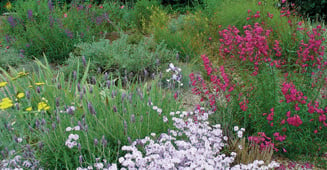

Contributor
- Topics: Archive
Where water is missing, life is all but impossible. Where water is scarce, nature improvises.
“San Diego’s New Water Conservation Garden,” a story by Sandra Younger that ran in the July 2000 issue of Pacific Horticulture, opened with the above simple straightforward sentence. Possibly more than most, gardeners are keenly aware of the connection between water and life—a factor that determines a landscape’s ability to flourish or fail.

In response to the historic drought conditions California is grappling with we’ve recently republished an excerpt of “Browning of the Greensward,” an essay by Russell A. Beatty that first appeared in the October 1977 issue.
“We have not really come to terms with living in the Mediterranean climate of California. Furthermore, we have become so detached form nature through dependency on modern technology that we have developed a lifestyle largely independent of the climate and the landscape.”
Lush tropical landscapes featuring plants from all over the world excepting, hot dry summers and increasingly brutal drought cycles are the norm for California. And while it may look different, warmer than average temperatures and a less-than-normal snowpack are having a devastating effect up and down the entire West Coast.
Like nature, gardeners must learn to improvise. For nearly 40 years Pacific Horticulture has been telling the stories of West Coast gardeners, their triumphs as well as their challenges, in print and now online as well. Our first compilation of stories addressing drought was posted in the spring of 2014. Thanks to further additions to our online archive project we’re pleased to expand our Drought in the Western Garden directory.
We hope the following stories provide you with information and inspiration as you improvise and form a creative response to changing conditions.
- Great Plant Picks 2011: A few for Sunny Dry Gardens
- Drought Tolerant and Shrubby Jasmines for West Coast Gardens
- Browning of the Greensward
- Water Use by Plants
- Some Approaches to Water Conservation in the Garden

- Grevilleas for the Maritime Pacific Northwest
- Monmouth Streetscape
- The Garden at Sparoza
- The Western Air-scape

- Making (the Most of) Rain in LA
- Leaning Pine Arboretum
- The New American Front Yard: Kiss Your Grass Goodbye! (book review)
- A Mediterranean Courtyard in Santa Monica
- Marnie’s Mediterranean Playground
- Why Use Mediterranean Plants int he Pacific Northwest?
- Creating a Southern California Garden—Slowly

- Our Berkeley Garden
- Some Like it Hot…and Dry
- Central Valley Gardening, Mediterranean Style
- The Mediterranean Garden: Image, Style, or Cultural Expression
- Greening Los Angeles
- Some Silver-leafed Plants in California’s Central Valley
- On a Sonoma Hilltop
- San Diego’s New Water Conservation Garden










Responses